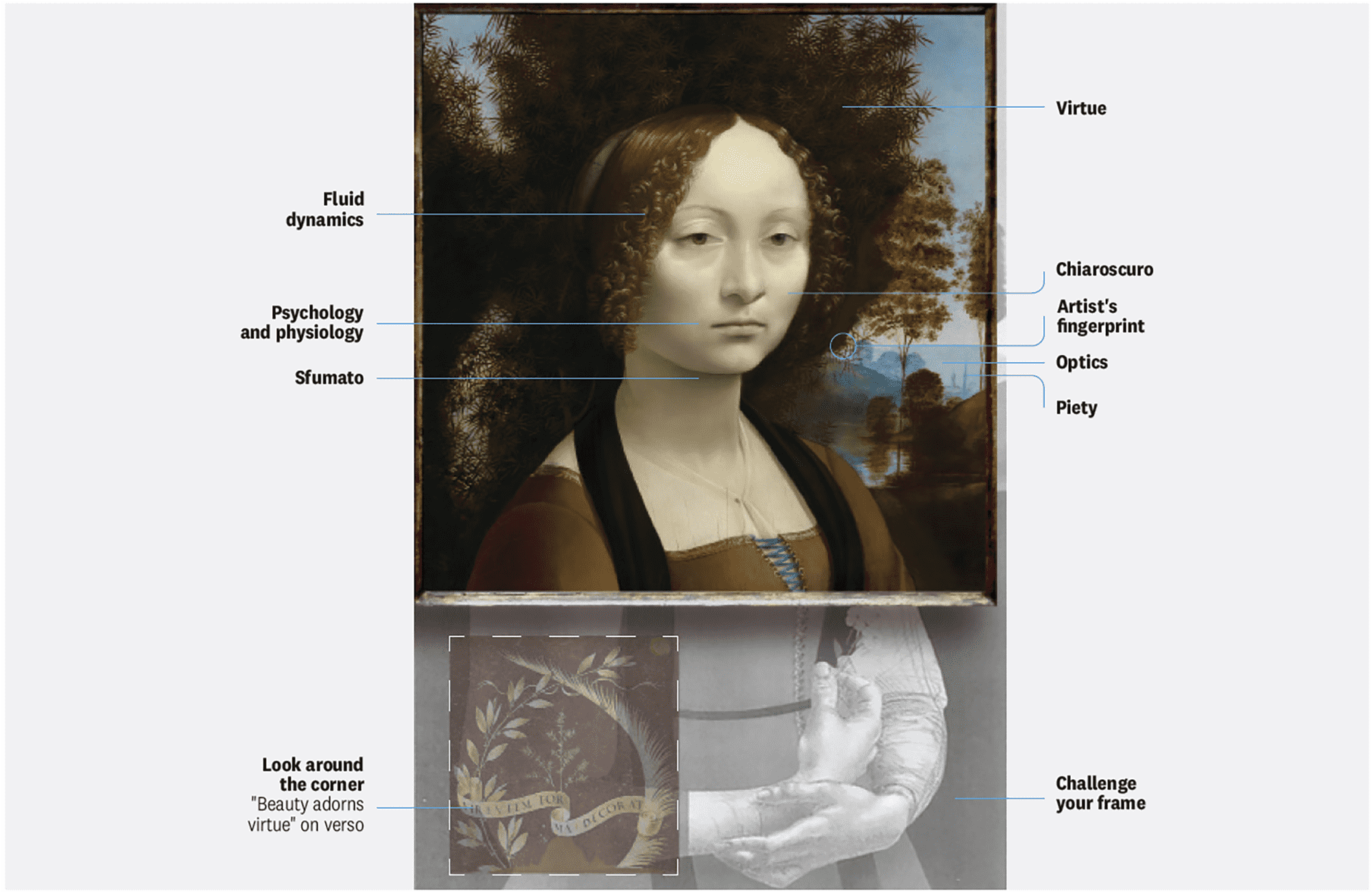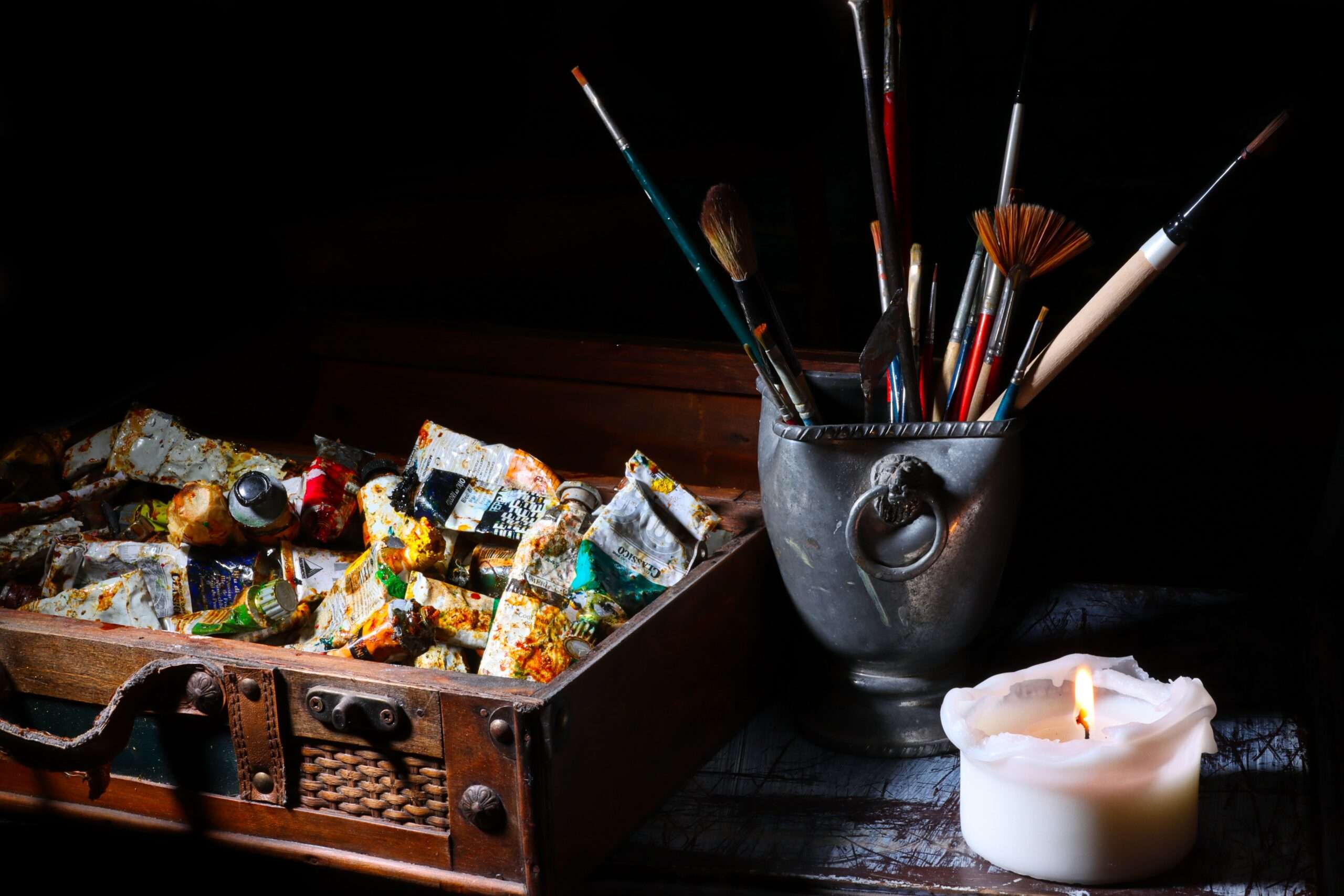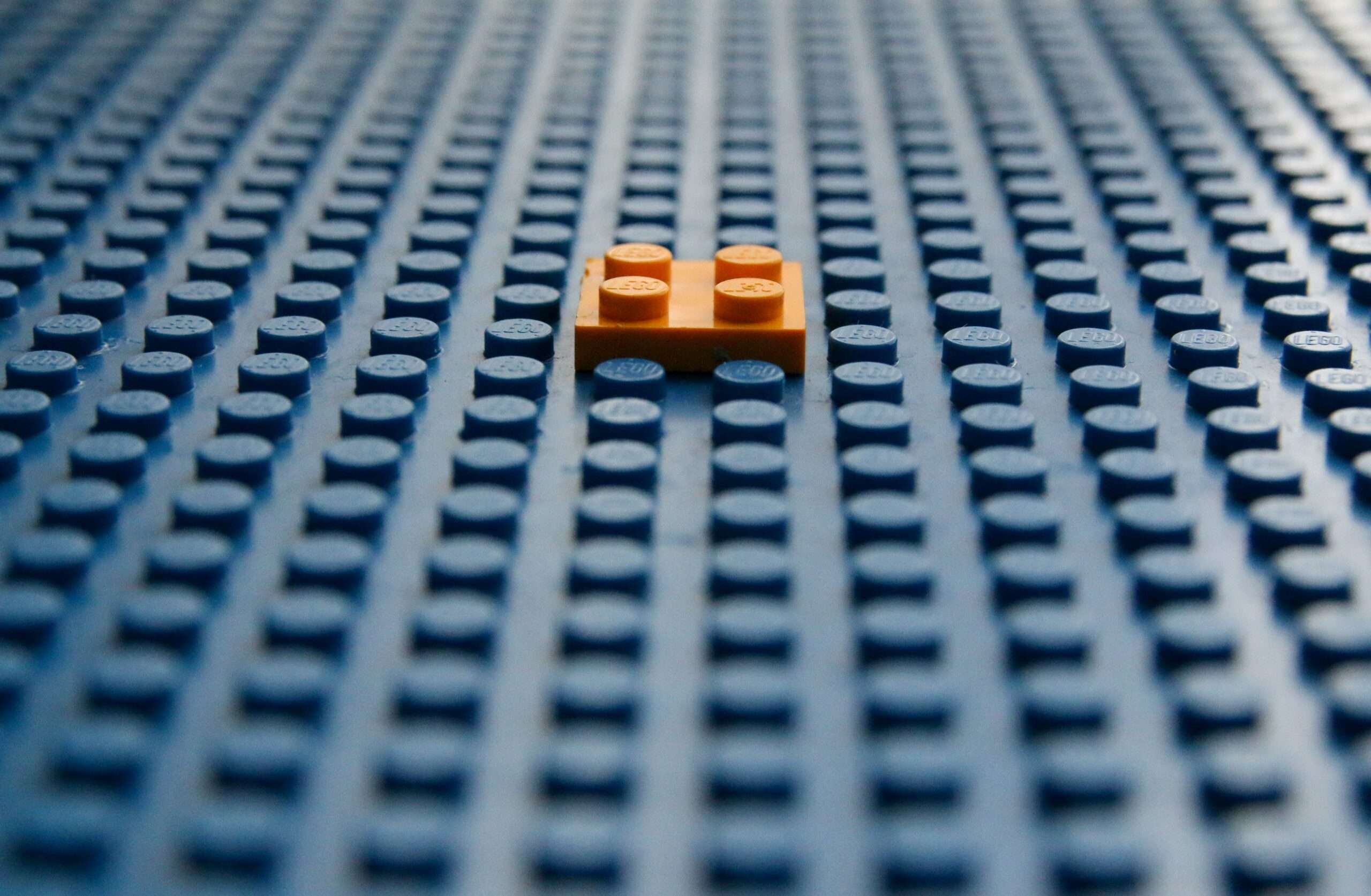Tapping into the convergence of art and science can help improve everything from strategic planning to performance management, but how do you do so? Let’s go straight to the source. Here are five leadership lessons gleaned from a Renaissance master.
In 1482, Leonardo da Vinci sent a job application letter to Ludovico Sforza, the archduke of Milan. Knowing his future employer was enmeshed in frequent military battles, the letter described Leonardo’s prowess at designing war machines, diverting rivers, building bridges, and designing weapons. He concluded his resume with the greatest understatement in art history: “I can also do … painting.”1 Indeed.
A pioneer in disciplines including fluid dynamics, optics, cartography, engineering, aviation, and anatomy, it was Leonardo’s ability to bring his science to art—and his art to science—that distinguished him in such a range of fields.
Leadership in these complex times similarly requires an adept mix of art and science—gut instinct balanced with data-driven decision-making, creativity coupled with systems thinking. And we can look to the works—and workstyle—of this Renaissance master to glean insights on how to deftly blend art and science in our own leadership.
“Principles for the development of a complete mind: Study the science of art. Study the art of science. Develop your senses—especially learn how to see. Realize that everything connects to everything else.”2
Leonardo da Vinci
Lessons from Leonardo were already apparent in one of his earliest paintings, the Ginevra de’ Benci, a portrait of a 16-year-old Italian aristocrat3 currently exhibited at the National Gallery of Art in Washington, D.C. It’s believed to have been painted between 1474 and 1478, and is the only painting by Leonardo in the Americas.
Exploring this painting reveals five lessons in leadership.

Find Unexpected Connections
In the Ginevra, Leonardo enhanced the realism of the portrait by making unexpected connections across multiple disciplines. For example:
Optics: Into the early Renaissance, most paintings were flat and two-dimensional. Because of Leonardo’s painstaking studies of the geometry of optics, he was one of the first major artists to achieve visual depth via one-point perspective4 by painting with reference to a single vanishing point on the horizon.
The artist also recognized atmospheric perspective: Objects that are farther in the distance appear to have less distinct edges, and a color shift toward blue occurs due to the atmosphere—both of which appear in the distance in the Ginevra. Leonardo’s observation skills may have been well-honed at a young age since both phenomena were apparent when viewing the town of Vinci from the porch of his birthplace.5
Fluid Dynamics: Leonardo was also committed to the study of fluid dynamics.6 His journals abound with sketches of the flow of water—such as around the abutments of a bridge spanning the Arno River—and his famous whirlpool in The Maelstrom. The curls of Ginevra’s hair mimic multiple such water studies, an image Leonardo also emulated in the curls of the angels’ hair in his famous Virgin of the Rocks.
Psychology and Physiology: Leonardo even connected the dots (apologies to the Impressionists) with psychology and physiology. Through dissection, he learned about the 27 different muscle structures in the face. By painting the faint nuances of those muscles in Ginevra’s face, he was able to communicate lifelike emotion.7
While you might not turn to fluid dynamics or physiology in your day-to-day work, Leonardo demonstrated that finding unexpected connections requires a leader to intentionally engage nontraditional disciplines. Research finds that “there’s great power in bringing together people who work in fields that are different from one another yet that are analogous on a deep structural level.”8 For example, philosophy has much to contribute to business, and some corporations now engage epistemological philosophers to advance AI and cognitive capabilities, and ethicists to help with purpose and moral decision-making amidst complex societal challenges.9
Challenge Your Frame
The Ginevra’s provenance demonstrates the damage leaders can cause when they try to fit every issue into their own frame. The Ginevra is displayed in a 15-inch by 15-inch square frame, but removing the painting from the frame reveals that the painting was sawed off on its right side and bottom. A significant portion of one of the greatest art pieces in the world was destroyed, presumably because it didn’t fit into an owner’s predefined frame. Art experts have tried to determine what the original painting may have looked like by connecting the dots between Ginevra’s silhouette and a related sketch of a woman’s hands found in Leonardo’s journals.10 Imagine how this expanded view could have added to the emotions evoked by the painting just by the positioning of this young woman’s hands.
Leaders should consider challenging the strategic frames within which their organization operates and redraw those frames out of either opportunity or necessity. During the pandemic, Airbnb broadened its frame from booking vacation rentals to providing virtual travel experiences. Uber expanded its frame from moving people to moving food too. And medical doctors globally redrew the physical boundaries of diagnosis and treatment from office to home via telehealth.
Sometimes organizations also need to tighten their strategic frames. Since its inception, Zoom prioritized the ease of customer experience, such as by displaying the meeting ID in the upper corner of the screen to share with new invitees. In the early days of the pandemic, the virtual meeting provider had to rapidly redraw its boundaries to tighten security and confidentiality when users—including world leaders—began sharing screenshots on social media of their virtual meetings during lockdown, unintentionally revealing their meeting IDs.11
See Through Others’ Experiences
What a viewer sees in the Ginevra depends on the lens they bring to the painting. An artist may notice techniques perfected by Leonardo to depict depth, such as chiaroscuro (the use of shadows based on how light falls on images) and sfumato (smokiness rather than hard lines on the subject’s jaw). A symbolist might recognize how Leonardo was communicating the subject’s character: The church steeple represented piety and the juniper branch was a sign of virtue in Italian culture.12 A Latin scholar might notice not just symbolism but also playful humor, the Latin word for juniper (ginepra) being a play on the subject’s name.13 And a forensic investigator may be intrigued to find Leonardo’s fingerprint embedded behind Ginevra’s right shoulder.
Stepping into someone else’s experience opens our own eyes as leaders to a richer depth of insights. Each year on Founder’s Day, the McDonald’s corporate office empties and its senior leaders work at the grills, front counters, fry stations, and drive-through windows of hundreds of their restaurants around the world—giving them a chance to see the experience from customers’ and store associates’ vantage points.14
Similarly, experiencing diverse strengths, skill sets, and viewpoints can help illuminate new ideas. The Santa Fe Institute, a research center focused on the study of complex systems, brings together business, scientific, educational, and other leaders, connecting multiple lived experiences and mindsets to “understand and unify the underlying, shared patterns in complex physical, biological, social, cultural, technological”15 systems in pursuit of a common goal.
Notice—and Make Use of—the Patterns
Patterns and rhythms are replete in mathematics, nature, and design. One such pattern—the golden rectangle16 is considered to be one of the most aesthetically pleasing and calming figures to the eye, and therefore, architects and designers have embraced it for centuries. Structures such as the Parthenon17 and the Taj Mahal exhibit this underlying pattern, and even today’s 16:9 TV screen approximates it.
Leonardo composed Ginevra’s portrait so that her face and bodice form a golden rectangle, and a bisection of the rectangle goes through her dominant eye. Further, we see a similar pattern in Leonardo’s two other well-known female portraits, the Lady with the Ermine and the Mona Lisa.18 Leonardo recognized that by embracing these natural patterns and reproducing them in his paintings, he could amplify the impact and aesthetics of his art. He was such an expert on the use of geometry in art that he illustrated Luca Paciolo’s classic book The Divine Proportion (the title being a synonym for the golden ratio).19
Notice and be conscious of the patterns that enable you, and those that impede you. We’re surrounded by patterns and rhythms: Company culture is a pattern; team structures are patterns; operating models are patterns. They’re all designed to bring structure, order, and consistency to an organization. Patterns can also be unhealthy, such as organizational silos (which tended to fall during the pandemic but are rapidly being rebuilt in many organizations). As leaders, we need to embrace the constructive patterns and ask what else they enable us to do, while naming the destructive patterns so that they can be dismantled.
For our own personal leadership journeys, rhythms are critical. How much of the fatigue and imbalance we often sense as leaders is a function of our fighting against natural rhythms such as sleep cycles, healthy eating patterns, and regularly disconnecting? In The Power of Full Engagement, the authors argue that the key to productivity is not time management but energy management. Their studies of multiple high-performing executives reveal that the “richest, happiest, and most productive lives are characterized by the ability to fully engage in the challenge at hand, but also to disengage periodically and seek renewal.”20
Look Around the Corner
The Ginevra is Leonardo’s only artwork painted on both sides. The back of the poplar panel is adorned with the words, “Beauty adorns virtue,” written in Latin against a backdrop of juniper and palm fronds. Although Ginevra’s visage greets visitors upon entering the gallery, the painting is mounted on a floating wall so that patrons can walk around it to view the reverse. Regrettably, many visitors to the gallery don’t “look around the corner” and, therefore, miss half of Leonardo’s paintings exhibited in the Americas.
Get up, walk around, and both literally and metaphorically look around the corners of your own organization and industry to evade orthodoxy, pinpoint risks, and enhance performance. As my colleagues Steve Goldbach and Geoff Tuff describe, “Innovation lore is littered with stories of brilliant minds coming to disrupt industry norms by seeing past [orthodoxy],”21 citing as an example the “corners” that traditional watchmakers failed to look around while smartwatches became the bestselling timepiece in the industry in just two years.22 In strategy workshops for our clients, we often have one breakout group assume the role of the C-suite of the biggest competitor—or a company in a totally different industry—to strategize how to disrupt the company from that new perspective. It’s an excellent exercise to become aware of preconceived barriers and corners.
To the best of our knowledge, Leonardo da Vinci never built or tested any of the designs he penned in his journals. In fact, the multiple war machines and weapons he described in his letter to Sforza were all conceptual, and Leonardo was considered a pacifist. Yet almost 500 years after his death, MRI technology proved that Leonardo’s journal drawing of a tripartite heart valve accurately depicted the workings of the circulatory system.23 Wings that he designed after thousands of hours of observing birds in flight were proven airworthy on a test flight captured by a National Geographic Society photographer in 2000.24 And an Italian loom that was posthumously built to Leonardo’s specifications in the 17th century is still weaving fine fabrics in Tuscany,25 the only known design of Leonardo’s in regular operation.
Leonardo offers us, as leaders, simple but profound wisdom for seeking the convergence of art and science: “It is useful to constantly observe, note, and consider.”26 His advice is as understated as his resume.
Brenna Sniderman of Deloitte’s Center for Integrated Research contributed to this article.
- Martin Kemp, Leonardo da Vinci: The marvellous works of nature and man (Oxford University Press, 2006), pp. 57–58; Colin Marshall, “Leonardo da Vinci’s handwritten resume (1482) ,” Open Culture, January 22, 2014. The full sentence translated as “I can carry out sculpture in marble, bronze or clay, and also in painting whatever may be done.” View in Article
- Leonardo da Vinci, “Quote by Leonardo da Vinci ,” Goodreads, accessed August 30, 2021. View in Article
- It is also the first of Leonardo’s three most well-known female portraits. The other two are The Lady with the Ermine (circa 1490) and the Mona Lisa (circa 1503 –16). View in Article
- Katelyn Macknyk, “Da Vinci’s use of one point perspective ,” Cove, February 10, 2020. View in Article
- Personal experience of the author. View in Article
- Walter Isaacson, Leonardo da Vinci (Simon & Schuster, 2017), p. 1. View in Article
- Stefan Klein, Leonardo’s Legacy: How da Vinci reimagined the world (Da Capo Press, 2010), pp. 18–25. View in Article
- Marion Poetz, Nikolaus Franke, and Martin Schreier , “Sometimes the best ideas come from outside your industry ,” Harvard Business Review , November 21, 2014. View in Article
- Scotty Hendricks, “Why having a philosopher in the office is good for business ,” Big Think, April 11, 2018. View in Article
- Bulent Atalay, Math and the Mona Lisa: The art and science of Leonardo da Vinci (Washington, D.C.: Smithsonian Books, 2004), p. 173. View in Article
- Jon Sarlin, “Everyone you know uses Zoom. That wasn’t the plan, ” CNN Business , November 29, 2020. View in Article
- Atalay, Math and the Mona Lisa , p. 172. View in Article
- Ibid. View in Article
- NewsVoir, “McDonald’s celebrates Founder’s Day in North and East India ,” ANI, October 9, 2019. View in Article
- Santa Fe Institute, “About ,” accessed September 13, 2021. View in Article
- A rectangle in which the ratio of its two sides equals the golden ration, or 1.61. View in Article
- Atalay, Math and the Mona Lisa, p. 71. View in Article
- Atalay, Math and the Mona Lisa, p. 176. View in Article
- Gary Meisner, “Da Vinci and the divine proportion in art composition,” goldennumber.net, July 7, 2014. View in Article
- Jim Loehr and Tony Schwartz, The power of full engagement: Managing energy, not time (Simon & Schuster, 2005), p. 12. View in Article
- Geoff Tuff and Steve Goldbach, Detonate, (Wiley, 2018), 2018, p. 47. View in Article
- Ibid. View in Article
- Kemp, Leonardo da Vinci, pp. 108–12. View in Article
- Atalay, Math and the Mona Lisa, p. 201. View in Article
- AFP, “The Florence silk mill still using a Da Vinci-designed machine,” The Local IT, December 18, 2018. View in Article
- Robert Krulwich, “Leonardo’s to-do list,” NPR, November 18, 2011. View in Article
The article was first published here.
Photo by Angelo Casto on Unsplash.

 1.0
1.0 


















